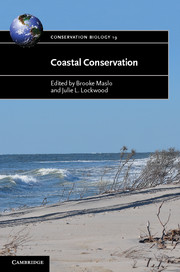Book contents
- Frontmatter
- Dedication
- Contents
- List of contributors
- List of abbreviations
- 1 The conservation of coastal biodiversity
- Part I Biodiversity Status of Coastal Habitats
- Part II Emerging Threats
- 8 The impacts of invasive species on coastal marine ecosystems
- 9 Climate change and conservation of waders
- 10 The impacts of climate change on marine turtle reproductive success
- 11 The effects of spilled oil on coastal ecosystems: lessons from the Exxon Valdez spill
- 12 Overexploitation of marine species and its consequences for terrestrial biodiversity along coasts
- Part III Synthesis
- Index
- Plate section
- References
9 - Climate change and conservation of waders
Published online by Cambridge University Press: 05 June 2014
- Frontmatter
- Dedication
- Contents
- List of contributors
- List of abbreviations
- 1 The conservation of coastal biodiversity
- Part I Biodiversity Status of Coastal Habitats
- Part II Emerging Threats
- 8 The impacts of invasive species on coastal marine ecosystems
- 9 Climate change and conservation of waders
- 10 The impacts of climate change on marine turtle reproductive success
- 11 The effects of spilled oil on coastal ecosystems: lessons from the Exxon Valdez spill
- 12 Overexploitation of marine species and its consequences for terrestrial biodiversity along coasts
- Part III Synthesis
- Index
- Plate section
- References
Summary
Introduction
The world’s climate is changing rapidly. In the last 50 years, global temperatures on land have risen by approximately 1°C, and over the next 100 years a further rise in temperatures of at least 2°C is expected (IPCC, 2007). This rise may not seem like much, but the rate of temperature change is unprecedented in recent history, and many animals and plants are struggling to keep pace (Chen et al., 2011). Wading birds (Charadrii) are particularly susceptible to climate change (Maclean & Wilson, 2011). Many species travel over large sections of the globe during the course of their annual cycle and use habitats in many different biomes and climate zones (Piersma & Lindstrom, 2004). The majority of waders breed in the high Arctic, a region warmer now than at any time in the last 125 000 years and undergoing further warming at a rate almost twice that of the global average. Other species breed in freshwater marshes, which are threatened by increased drought. During the winter periods, the majority of waders move to coastal habitats where they experience climate-related threats associated with the marine environment. Global sea level rose ~17 cm during the last century, but the rate in the last decade is nearly double that of the last century (Church & White, 2006). Significant habitat loss and change has occurred as a result, and even greater changes are expected in the future (Chu-Agor et al., 2010). The magnitude of future changes in sea level are very difficult to predict because of uncertainties associated with understanding the extent of polar ice sheet loss. However, the last time polar regions were significantly warmer than at present for an extended period, reductions in polar ice volume led to 4–6 m of sea level rise (IPCC, 2007). Marine invertebrate prey of waders are also susceptible to changes in ocean chemistry. Ocean acidity has increased by ~30% as a result of higher levels of dissolved carbon dioxide, with concomitant deleterious impacts on calcifying organisms (Orr et al., 2005). Moreover, temperature increases and changes in ocean circulation patterns have been linked with reductions in dissolved oxygen in coastal and marine systems, with extremely damaging consequences for the fauna associated with these habitats (Grantham et al., 2004). Many of these species are part of the food web on which waders rely.
- Type
- Chapter
- Information
- Coastal Conservation , pp. 265 - 286Publisher: Cambridge University PressPrint publication year: 2014

